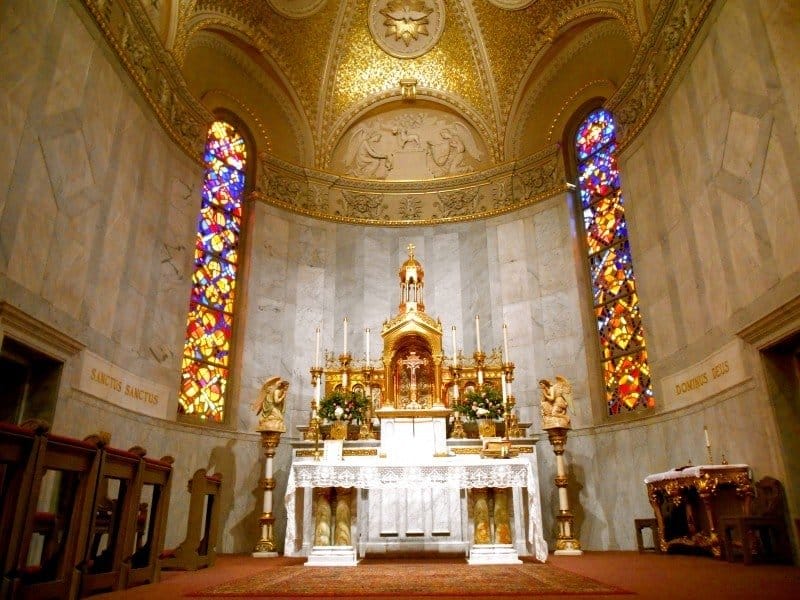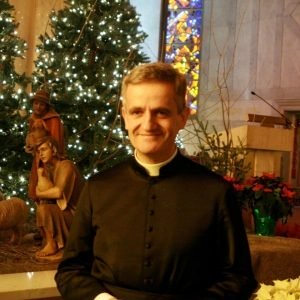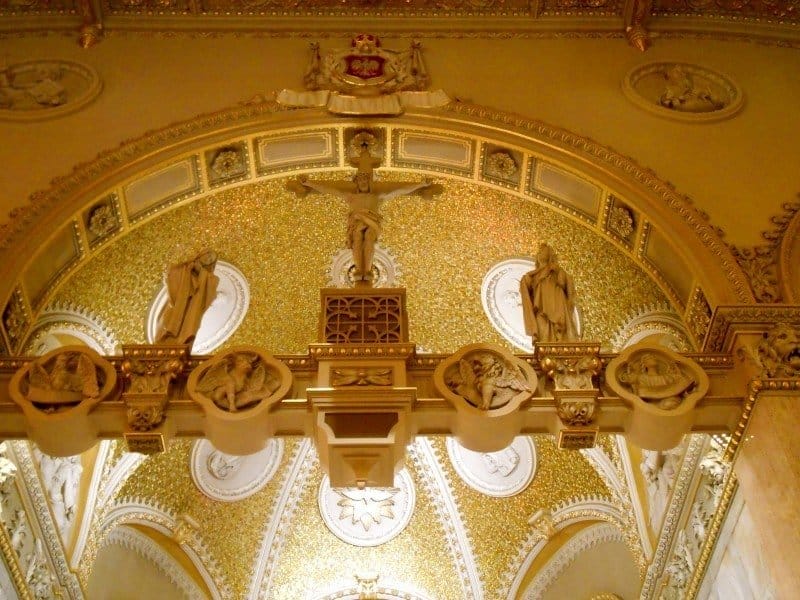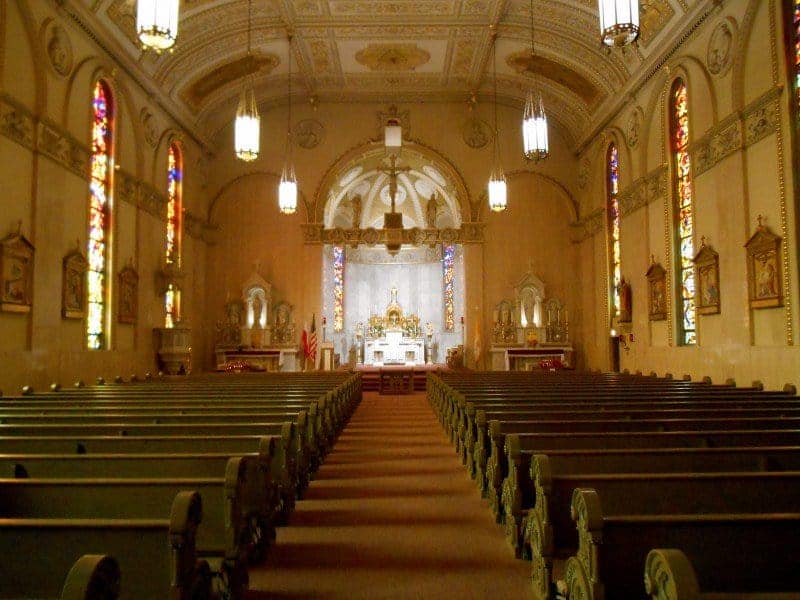It’s hard to miss Saint Stanislaus Catholic Church. Built in 1872, it’s one of Milwaukee’s oldest, iconic buildings. (The parish itself dates back to 1866, the present building dates to 1872.) Driving south on I-94, the twin steeples of the historic Cream City brick church stand tall, overlooking the South Side of Milwaukee. The elegant towers, each topped with a ten-foot stone cross, are visible for miles (and in the heading of our website). The church is an enduring testament to Milwaukee’s industrious Polish immigrant community. Megan Daniels, author of Images of America: Milwaukee’s Early Architecture, describes the building as “one of the city’s most recognizable churches, exhibiting influences from Eastern European Romanesque churches.” Combining Cream City brick and heavy hints of its timeless European heritage, Saint Stanislaus offers the best of both worlds, new and old.
The 1960s however, under the direction of Monsignor Raymond Punda, proved traumatic for the interior of the church, as strikingly incongruous and, I would add, theologically suspect alterations were okayed under the auspices of the “Spirit of Vatican II.” Gaudy, dated carpeting was brought in to cover the original flooring; the multi-leveled sanctuary was leveled out with the help of concrete which was poured by the tons into the sanctuary (the concrete addition was so heavy that support beams had to be installed underneath the sanctuary); the original, brilliant stained-glass windows were extracted and replaced with distracting modern windows that resemble thousands of broken bottle shards. In addition, two elegant marble shrines, situated along the walls of the nave, were removed to who knows where. The exquisite white marble altar rail was destroyed, with only two sad pieces of it remaining to serve as reminders. And finally, the sanctuary was obtrusively extended far out into the nave. It was bad, friends. Catholic or not, no one with any sense of historical and theological perspective, let alone good taste should have signed off on such a scheme. Why it was allowed to proceed unchecked is a maddening mystery. But it was the 60s, folks. Need I say more? (Many historic parishes faced similar fates during this era of neo-iconoclasm.)
The parish’s centenary in 1966 gave Monsignor Punda a golden opportunity to go big with the radical renovation project. A commemorative book from that year offers the reader strained, sometimes laughable rationales, dripping with 1960s-era Catholic clichés, to justify the changes. Here are some choice excerpts:
It is more than a coincidence that the beautifully renovated St. Stanislaus should reflect the spirit of restoration in the Catholic Church today. Each alteration and design was planned with the modern liturgy in mind. [Just what exactly is the “modern liturgy”? It’s a completely made-up term with no basis in Church documents. Phrases like that were regularly invented ex nihilo to justify the renovations.]
As always, through the years, St. Stanislaus has kept up with the times. [Whatever that means…] Since 1866, progress has been the keynote, the abiding heartbeat of this very active parish. In this age of liturgical revival, therefore, it is not extraordinary that this great church should embody the physical symbolism of modern Catholicism. [Progress isn’t necessarily bad, but it’s very vague. It needs to be defined. Of all the things that the Church represents, all the theological depth and richness, is “progress” the first word that comes to mind? I’m not sure that “progress” was first in the minds of those industrious and devout Poles who donated and sacrificed to embellish the church in its early years. “Tradition” comes to mind.]
Referring to the modern windows, the book comments:
They [the windows] depict no story or symbolism, as was customary in church windows designed 100 years ago; rather, they reflect a modern ecclesiastical theme in keeping with the laity’s participation in the Mass. [Please define “a modern ecclesiastical theme”…] The purpose of the window is to create an aura of beauty and warmth, to contribute rather than to detract from our complete absorption in the modern liturgy. [So, traditional stained-glass windows “detract” from the liturgy?]
And on the removal of the altar rails, the book says: “Two communion stations are all that remain of the old communion rail, thus minimizing the visual barrier to the main altar.” First of all, the sanctuary is already elevated from the nave by a number of steps. Second, the high altar within the sanctuary is elevated yet again by another series of steps. So, a short three-foot communion rail at the sanctuary’s entrance can hardly be described as a “visual barrier” to the people as, originally, two levels of elevation were present to improve the visuals of the Mass. The book’s rationale is, of course, sheer nonsense. But again, attractive (yet never clearly defined) catch phrases like “modern ecclesiastical themes”, “spirit of restoration”, “visual barriers” and “modern liturgy” were relentlessly employed by the indefatigable architects of this revolutionary liturgical enterprise in order to fashion a new, unprecedented liturgical order that ensured a radical break from tradition.
And on and on the book goes. Hackneyed cliché after hackneyed cliché. Incidentally, in the years following the modern renovations and “modern liturgy,” which were intended to inject new vigor into the church, parish life at Saint Stanislaus dropped significantly, as parishioners checked out.
Thankfully, despite all the damage, much of the interior’s original beauty remains, from its captivating, suspended crucifixion scene (donated by grateful survivors of a devastating flood), to its beautifully carved pews, the baroque engravings in the ceiling, the white marble high altar and two side altars dedicated to the Sacred Heart of Jesus and the Virgin Mary. We can also be grateful that the current custodians of the parish, the Institute of Christ the King Sovereign Priest, an international society of tireless defenders of Catholic tradition and culture, have set in motion a bold and ambitious restoration project aimed at bringing back as much of the church’s former glory as possible.
While some of the restoration consists of long-overdue maintenance and upkeep (roof repair, ventilation, etc.) much of the attention focuses on undoing the 1960s-era damage. Anyone who appreciates the preservation of Milwaukee’s well-documented architectural heritage can be grateful to the Institute of Christ the King for this endeavor. By taking this corrective measure, the Institute is giving back to Milwaukee’s future generations of Catholics and non-Catholics a priceless piece of their old-world heritage.
Ever since then-Archbishop Timothy Dolan gave the parish over to the care of the Institute of Christ the King in 2007, the Oratory of Saint Stanislaus has served as one of the very few parishes in Milwaukee where the traditional, 1,500+ year-old Latin Mass is offered on a daily basis. The parish is a growing bastion of tradition and beauty. No folksy guitar music and schmaltzy hymns here. While rooted in ancient liturgical tradition, and perhaps because of this, young Catholics are drawn to Saint Stanislaus in considerable numbers. At a time when it’s “in” to be unconventional (think Milwaukee’s East Side) Saint Stanislaus’ counter-cultural modus operandi is, without a doubt, a huge part of its appeal among the younger generation. In a paradoxical kind of way, the seemingly nonconformist approach to liturgy at Saint Stanislaus is rooted in centuries-old rituals, which the younger crowd sees as something new, and beautiful. The parishioners understand well what Pope Emeritus Benedict XVI once wrote: “The more priests and faithful humbly surrender themselves to this descent of God [at liturgy], the more ‘new’ the liturgy will constantly be, and the more true and personal it becomes.”
I recently met with the rector of the parish, Canon Benoît Jayr, a native of Montauban, France, who has been at Saint Stanislaus since 2011. He filled me in on the particulars of the fascinating restoration project currently underway at the parish. He showed me old photos dating from the golden age of Saint Stanislaus, which now serve as invaluable reference points for the ongoing work. We also discussed parish life, the allure of the Latin Mass, the importance of tradition, and his Montauban-to-Milwaukee transition.
What is the driving motivation behind the renovations at Saint Stanislaus? Some might say, “What’s the point?” Is this just about one’s aesthetic preference over another’s?
We have a beautiful Polish inheritance here and, I believe, we have a solemn duty to preserve that patrimony. The continuity and preservation of these traditions, even in terms of architecture, are extremely important for the missionary impact of Saint Stanislaus, which is, of course, the conversion of souls. The parish building itself is well-known. Visitors who arrive at Mitchell International Airport will see the church recreated, along with other famous Milwaukee buildings, in a colorful floor mosaic. So already, the church greets visitors even before they see the actual building. We can also say that the building itself is a tool for evangelization, and not just a historical building. When talking about the decision to restore the original integrity of the interior I must add that many of the 1960s renovations are totally opposed to the basic architectural style of the original building. Anyone will notice that the modern windows and the renovated sanctuary, for example, are not congruous with the original design.
In your view, what was the reason why so many of these radical and financially exorbitant renovations took place in Catholic churches across America in the 1960s and after? For example, what inspired the removal of altar rails?
In the Church, and in society in the 1960s, we saw a big desire to change everything. It was a time of great turnover, we could say, and of innovation. The scope of such renovations in church buildings was allegedly to give more dynamism. It was supposed to represent a new spring for the Church. But this season was disappointing, as the promised fruits did not show up.
As a member of the parish, I am regularly impressed with the large number of young adults and families that are parishioners here. During Sunday mass, it seems like the entire back half of the church is taken up by numerous young families with lots of kids. I’ve observed younger Catholics flocking to traditional parishes in many cities across America, and I’ve heard that the same is true in France. Some may find it surprising that young people, instead of demanding novelty and innovation and reviling tradition, are actively seeking out and demanding tradition. How do you account for this phenomenon?
Obviously, this young generation does not merely have a sentimental nostalgia for the old times, since they didn’t experience those times first-hand. This liturgy corresponds to a strong desire for an interior life. The young are very sensitive to reverence in liturgy, worship, and adoration. From the start, this liturgy requires from those who discover the Latin Mass something very demanding, because today, of course, no one speaks Latin. This generation wants something with depth; they desire to find in the Mass a direct contact with the presence of the divinity. The silence and reverence of the Mass are very appealing as well to this generation. All over the world, parishes that offer the Latin Mass are filled with young Catholics. This is very true in France (as in America), as we see many young people and very large and numerous families. (It is often a concert of babies in the back of church!) I will say also that the young need strong reference points in an increasingly hostile, secular culture. In this secular world, the Latin liturgy brings the sacred down to earth, which is precisely what we need.
How can the Latin Mass, with its emphasis on ancient tradition, benefit a world and culture that place so much emphasis on “out with the old”?
The Latin Mass is rooted in the early church. It brings stability, depth and a permanent, unchanging reference point to our world, which is always moving, always changing. This liturgy focuses on God. In a society that is increasingly self-centered, the Latin Mass is conspicuously theo-centric, God-centered.
What are some common misconceptions you hear about the Latin Mass that you would like to set straight?
The main concern that we hear is “We do not understand what the priest is saying.” But think about it, can anyone really understand that which is a mystery? If you want to approach God, give up your own personal concepts and quest for certitude. The traditional liturgy asks us to be more receptive, and open to interior contemplation, instead of being busy and active. It helps us feel less agitated. The use of Latin leads us in this mystery because this language is not a daily language; it is reserved solely to talk with God. Further, this language is stable, the meaning of the words do not change to express the truths of faith, which are by definition eternal, immutable. The use of the Latin language also mirrors the unity of the Catholic Church. In our modern time, we travel a lot, and it is nice to find the exact same liturgy, wherever you may be. Latin brings together, it unites, rather than scatters. Finally, the priest offering Mass ad orientem (facing East) is like the shepherd leading the flock to heaven. We do not need to see the smiling face of the priest, with his beautiful white teeth, in order to pray stronger. The efficacy of the Mass does not depend on the quality of the “actor.” The Mass is not a TV show! It is totally different. It is adoration given to God, not adoration of the community.
Seminarians of the Institute of Christ the King come from all around the world. What common thread unites this diverse group of young men? Why are they attracted to the mission of the Institute?
Young men from all over the world reach the Institute of Christ the King and here they can find a true sense of the universality of the Church, which transcends the national particularities of the different cultures. There is a strong sense of what we call in Rome “romanitas” which is, more or less, the living, visible culture of the Roman Catholic Church. The Institute also teaches seminarians how to become good priests, how to serve souls and, of course, the Church. At the Institute, they find a strong spirit of family and, during the seven years of formation in the seminary at Gricigliano, which is near Florence, they develop a true zeal for this service to God.
We’re a long way from France. What are your early impressions of living in Milwaukee?
I like Milwaukee because it was founded by a French man, Solomon Juneau! Also, it is a land of cheese, like France! For a European, Milwaukee is a great window to discover America. This city is not too big and not too small. The lake however is like the sea. The people here are very welcoming. My parishioners are very helpful with me, even when they don’t understand my accented English! As for the faith of the people, this region is the heart of America, where you find a strong faith and deep values. Of course, it is not the America you see on the television screen in France, unfortunately. Simply put, here it is the real America.









